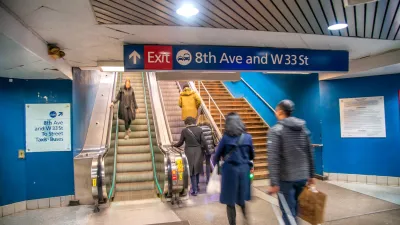Maureen McAvey, Executive Vice President with the Urban Land Institute, spoke recently to a congressional committee on the growing problem of federal buildings that are designed with myopic attention to security and ignore urban growth strategies.
 In the nearly ten years since 9-11, the U.S. government has elevated its resolve to protect federal facilities against terrorist attacks. More frequent bag searches and identification disclosures have morphed into more street closures, more building buffers, blast-resistant façade hardening, and more prohibited access. Now, these tight security measures for existing locations are increasingly being set aside for strategies to move federal facilities into more isolated - and theoretically less vulnerable - settings. This raises the question: How much building security is too much?
In the nearly ten years since 9-11, the U.S. government has elevated its resolve to protect federal facilities against terrorist attacks. More frequent bag searches and identification disclosures have morphed into more street closures, more building buffers, blast-resistant façade hardening, and more prohibited access. Now, these tight security measures for existing locations are increasingly being set aside for strategies to move federal facilities into more isolated - and theoretically less vulnerable - settings. This raises the question: How much building security is too much?
At what point do our federal facilities become fortresses to avoid, instead of inviting places that support thriving communities?
To be sure, some federal agencies and departments - including the Department of Defense - have much stricter security needs than others that determine where they are located. But, regardless of the department or agency, no decision involving federal employee relocation is insignificant, in terms of community impact. It would serve the federal government well to rethink its relocation policies related to security, to ensure that these policies and guidelines work with urban growth strategies, rather than against them. Too often, security proposals for individual buildings are developed to satisfy existing security standards for individual buildings, and do not balance improved building security in the context of broader measures, such as neighborhood-based strategies and local economic development considerations.

Going too far with restrictions on location and access could undermine the progress that has been made in urban revitalization over the past two decades. According to the U.S. Census Bureau, residential construction in urban neighborhoods -- including smaller as well as larger markets -- has risen steadily since 1990. This reflects a trend in which cities across America have been rediscovered as places to live and work, not just work and leave. Urban migration has resulted in more compact, less isolated development that incorporates mixed land uses and transit connections to improve mobility and foster a greater sense of community. It's brought us cities that operate more efficiently.
Fortifying individual buildings in which there is a federal presence through extreme measures that discourage or prohibit connections with adjacent developments and the greater community would have a highly disruptive impact. Ultimately, cities are about people, not buildings. While we speculate as to whether people will leave our cities because of threats of terrorism, we know for certain that they will leave if they are fed up with a low quality of life due to inefficient land use patterns and transportation networks. What we have learned from this urban revival is that the long-term fortunes of cities are being determined by their ability to attract people to places that are as appealing to live as they are to work.
More balance is needed between heightened security and urban sustainability. Here is an idea for federal agencies who determine strategic locations for and dispersals of government agencies and functions: Resist over-reactive building-based measures that hamper the quality of life in the greater community. Instead, focus on an approach that enhances economic development opportunities and community livability.
This is not just an issue for the Washington, D.C. metropolitan market. The location of federal employees, in any community, forms a strong employment base of federal workers and federal government contractors. It can change the course of economic development for an entire region. Locating near transit, and in existing buildings in more centrally positioned locations, is conducive to urban sustainability. Locating in far-flung, car-dependent locations that place additional pressure on infrastructure is conducive to urban sprawl. This is more than a building design or a planning coordination challenge. Leveraging federal facility investments requires a sophisticated real estate strategy.
There are numerous benefits to be gained by taking an "anti-sprawl" approach to federal facility security. Using this approach, federal leasing activity can:
- Be located in highly accessible locations that have broad and efficient connections to a cross-section of affordable and work-force housing alternatives. By encouraging all opportunities of "co-location", existing investments in local infrastructure are leveraged and future investments in local infrastructure are minimized.
- Be structured as a "development catalyst" that enables and encourages complementary private-sector mixed-use investment in adjacent sites, especially in brownfield locations, where infrastructure and remediation costs can be structured for broader community benefit at no additional expense to the federal government.
- Target buildings and sites that are considered by local planning officials to be underutilized in terms of land use densities, such as abandoned/underutilized shopping malls, commercial office buildings or industrial areas.
- Be oriented towards public transportation and thereby reduce or eliminate the need for conventional parking ratios. Federal leasing can not only encourage the use of public transit, but also facilitate and intensify the level of pedestrian travel in a given location.
- Include land use and building program elements that advance community and neighborhood economic development, such as the inclusion of storefronts, temporary markets and farmers markets.
- Employ strategies that creatively leverage federal "support" functions (food and beverage, conference facilities, childcare uses) in a manner that conforms to active ground-floor use objectives set forth by local land use planners. This not only promotes the connection of building users to the neighborhood context, but also makes these service spaces available for use by surrounding residents.
- Where necessary, provide an investment in shared parking facilities in a manner where those facilities can become a community asset and shared during non-business hours.
To be sure, finding the "sweet spot" between protective measures and community livability is no small task. But the only chance of getting there is by broadening the overall goal to more than just building security. An effort should be made to understand the positive impacts that federal facilities and federal uses can have in fostering sound economic development.
Perhaps the best advice on federal building security policies came from the late U.S. Senator Daniel Patrick Moynihan, who, not long after 9-11, was awarded the Urban Land Institute's highest honor, the ULI J.C. Nichols Prize for Visionaries in Urban Development. During his acceptance remarks in October 2001, Moynihan urged ULI members not to be deterred by random terrorism, and to stay focused on building better cities. He said, "The only way they (terrorists) can win is if we change the way we live, and a lot of us live in cities."
We would do well to move forward with federal real estate policies that enhance the livability of our urban areas, and help sustain the people who live and work in them.
Urban Land Institute Executive Vice President Maureen McAvey recently discussed the need to balance security concerns with community sustainability during testimony before the U.S. House of Representatives Subcommittee on Economic Development, Public Buildings and Emergency Management. The subcommittee, chaired by U.S. Representative Eleanor Holmes Norton, (D-DC), is part of the U.S. House Transportation and Infrastructure Committee.
The Urban Land Institute is a nonprofit education and research institute supported by its members. Its mission is to provide leadership in the responsible use of land and in creating and sustaining thriving communities worldwide. Established in 1936, the Institute has nearly 30,000 members representing all aspects of land use.

Alabama: Trump Terminates Settlements for Black Communities Harmed By Raw Sewage
Trump deemed the landmark civil rights agreement “illegal DEI and environmental justice policy.”

Planetizen Federal Action Tracker
A weekly monitor of how Trump’s orders and actions are impacting planners and planning in America.

The 120 Year Old Tiny Home Villages That Sheltered San Francisco’s Earthquake Refugees
More than a century ago, San Francisco mobilized to house thousands of residents displaced by the 1906 earthquake. Could their strategy offer a model for the present?

San Francisco Opens Park on Former Great Highway
The Sunset Dunes park’s grand opening attracted both fans and detractors.

Oregon Legislature to Consider Transit Funding Laws
One proposal would increase the state’s payroll tax by .08% to fund transit agencies and expand service.

Housing Vouchers as a Key Piece of Houston’s Housing Strategy
The Houston Housing Authority supports 19,000 households through the housing voucher program.
Urban Design for Planners 1: Software Tools
This six-course series explores essential urban design concepts using open source software and equips planners with the tools they need to participate fully in the urban design process.
Planning for Universal Design
Learn the tools for implementing Universal Design in planning regulations.
Clanton & Associates, Inc.
Jessamine County Fiscal Court
Institute for Housing and Urban Development Studies (IHS)
City of Grandview
Harvard GSD Executive Education
Toledo-Lucas County Plan Commissions
Salt Lake City
NYU Wagner Graduate School of Public Service





























